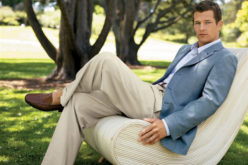Q. What kinds of lighter sweaters are currently in style? I am thinking of the coming cooler months before I rely on bulky warmer sweaters. What sweaters can I wear that could be a top layer alone or go under a blazer, a windbreaker, or a full coat?
A. Generally speaking your old sweaters will still be in style, unless they have very flashy, bright-colored patterns. Men’s sweaters are versatile, and your options are almost endless. One of the pluses about sweaters is that you really don’t have to concern yourself with which types are currently in – or out of – style, because there is not much that changes over the years. I can hardly think of any type that has become outdated. . . except, perhaps, the Italian gondolier’s boat neck. Certainly, you may see more of one type in fashion magazines than another, but not to worry.
A sweater is one of the most flattering garments a man can wear. It adds weight to a skinny physique and streamlines a large silhouette. It can help create optical illusions that flatter your body. If you are very tall or very thin, opt for sweaters with horizontal stripes or argyle patterns. If you have “love handles” that need hiding, a sweater that comes down a few inches past your waist directs the eye past your waistline and helps camouflage any excess girth. The important question regarding sweater selection is which types do you like best, and that involves considering cut/neckline, material, patterns, and colors.
CUTS AND NECKLINES
Sweaters come in two basic cuts, pullovers or cardigans. Versatile pullovers offer the most options, including crew necks, V-necks, sleeveless vests, turtlenecks, polo styles, henleys, and quarter-zip fronts.
Cardigans to fit every man’s style are either button-up or zip-fronts. Today’s cardigans do not have a baggy grandfather air; they are cut trimmer and are quite stylish. You can create many looks with cardigans, from professorial to fashion-forward, and on to big man on campus (however, I would not recommend a cardigan under a blazer). A slim-fit cardigan made of a dressy silk-and-wool blend can be worn with a business shirt for a business/casual combination, or it can be dressed down with a handsome sport shirt for weekend attire and casual streetwear.
MATERIALS
Sweater fibers may be cotton, wool, cashmere, or synthetics. Often, they are a blend of two or more of these. Which ones you choose depend on your preference, the season, your pocketbook, and the occasion. The only ones I don’t recommend are those with a high percentage of synthetic. In most cases they will be of lower quality than their wool and cashmere counterparts.
Pay attention to the major component (the bulk of the fiber). If it is mostly wool or cotton, the sweater will behave like the basic ingredient (for example, wool could shrink in the laundry). Some fibers, such as rayon, are not designed to be laundered, and must be dry-cleaned.
PATTERNS
Sweaters come in solids and a huge range of patterns. Solids are safe; patterns add interest. Solids are the most formal; patterns can make the garment more casual. Some subtle patterns appear from a distance to be solid (such as tweeds, small checks, herringbones). Some patterns are large and distinctive (such as argyles, stripes, Fair Isle, and cable stitched).
The trick to wearing a patterned sweater successfully is to understand that the sweater’s pattern will be the focal point of your outfit. Match it with simple (usually solid-color) items that do not compete with it.
COLORS
Blue, black, beige, and gray are the most versatile sweater colors; they look good in most sweater styles. On the other hand, even though vivid colors are usually not appropriate for men’s suits and blazers, bright colors are very much accepted for sweater dressing. They can be playful and fun.
As you suggested, whether you are talking about lighter weight or bulky sweaters, you need to consider if you intend to wear the sweater alone or layered under a blazer, any other jacket, or a slim topcoat. If possible, you should bring the jacket you might wear over the sweater when shopping. You might find that you can’t get your sleeves into your usual jacket without feeling as if you are stuffed into it uncomfortably.
Please send your men’s dress and grooming questions and comments to MALE CALL: Lois.Fenton@prodigy.net









